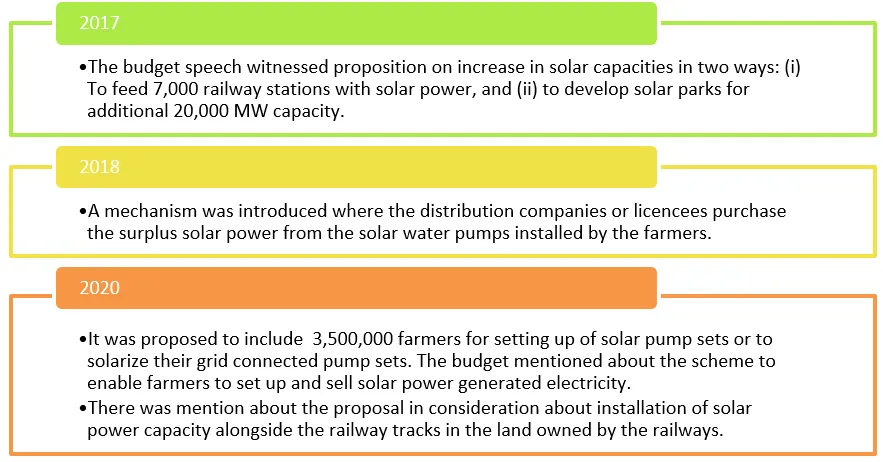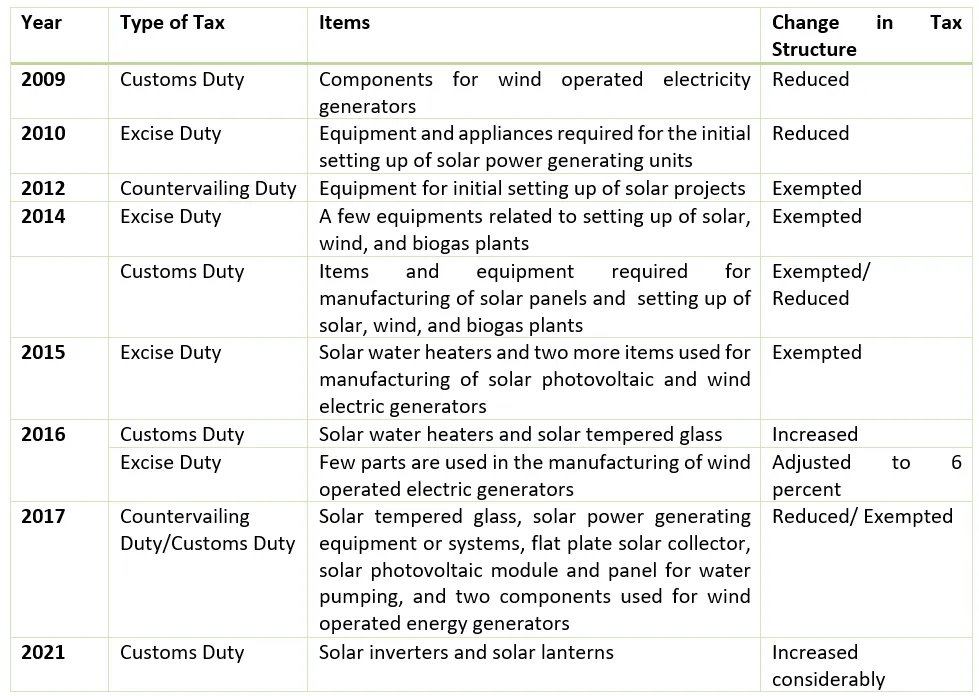-
CENTRES
Progammes & Centres
Location
As India aims to achieve its climate commitments, the significance of renewable energy keeps on growing as reflected in the union budgets over the years.

India ranks fourth in the world for overall installed renewable capacities. The total installed capacity of renewable energy (only wind) in the year 2000 was 1,155 MW, about 1.2 percent of the total installed capacities. In the year 2022, the installed generation capacity of wind, solar and other renewable energy sources stand at 105,854 MW, about 27 percent of the total installed generation capacities. India witnessed considerable growth in renewable-based installed capacities, especially in the last decade.
Renewable energy made significant progress in total installed capacities in India and is reflected in the budget speeches that explore various resources and policy mechanisms to harness renewable energy, especially solar, in an efficient way.
The Union Budget 2022-23 was announced in February 2022. Union budgets are one of the important benchmarks to understand the progress or direction of any sector. This article reviews the budget speeches from the year 2000 with two objectives: (1) To present a consolidated narrative, and (2) to retrospect the path of renewable energy in the union budgets.
All the propositions, revisions, and announcements in the budget speeches from 2000 to 2022 are segregated into four major heads: (1) Renewable Energy Targets and Capacity Additions, (2) Duty and Taxes, (3) Capacity Building, and (4) Incentives.
Figure 1 presents the segregation of points linked to Renewable Energy in the budget speeches.
Source 1: Author’s Own based on the Union Budget Speeches from 2000-2022
Renewable energy targets and capacity additions: Initially in India, wind dominated the renewable energy space. In the year 2006, India achieved its wind energy target of 3,075 MW (as mentioned in the 10th five-year plan) and a sum of about INR 5,970 million was proposed for renewable energy. Later, the focus shifted to solar energy. The budget speech in the year 2015 was of significance for renewable energy as it revised the target to 175,000 MW by the year 2022 which included 100,000 MW of solar power. The renewable energy targets and capacity additions mentioned in the union budget speeches are presented in Figure 2.
FIGURE 2: RENEWABLE ENERGY TARGETS AND CAPACITY ADDITION IN UNION BUDGET SPEECHES (2000 – 2022)
 Source 2: Consolidated by the author based on the Union Budget speeches from 2000 to 2022
Source 2: Consolidated by the author based on the Union Budget speeches from 2000 to 2022
Duty and taxes: There were exemptions and reductions in customs and excise duty for the components used in the generation of solar and wind power to boost the installation of renewable energy based power plants. The revisions in customs and excise duty in the union budgets are presented in Table 1.
Table 1: Revisions in Customs and Excise Duty related to Renewable Energy in Union Budgets (2000 to 2022)
 Source 3: Consolidated by the Author based on the Union Budget Speeches from 2000 to 2022
Source 3: Consolidated by the Author based on the Union Budget Speeches from 2000 to 2022
The budget speech of 2010 introduced a clean energy cess on imported coal to build the corpus of clean energy fund. In 2019, the scheme for the provision of investment-linked income tax exemptions under section 35 AD of the Income Tax Act, and other indirect tax benefits for the global companies for setting up mega-manufacturing plants and related areas was announced. The goods and service tax (GST) was reduced considerably in the year 2019 for biomass briquettes.
Capacity building: The budget speech of the year 2003 mentioned the allocation of INR 200 million towards incentive-driven research in solar energy, wind turbines, and hydrogen fuel as alternatives to fossil fuels. The year 2013 saw a major development in the form of low-cost finance. The government announced to provide low-interest-bearing funds from The National Clean Energy Fund to Indian Renewable Energy Development Agency Limited to lend to viable renewable energy projects. Capital infusion of INR 10,000 million for Solar Energy Corporation and another INR 15,000 million for the Indian Renewable Energy Development Agency was proposed in the year 2021.
Generation and production-linked incentives: The budget speech of the year 2009 suggested pursuing an Integrated Energy Policy. The Integrated Energy Policy document, which was released in the year 2006, recommended that the incentives for renewables shall be linked to energy generated rather than capacity installed. In the year 2013, generation-based incentives for wind power were reintroduced, and INR 8,000 million was proposed for the Ministry of New and Renewable Energy for the purpose. The budget speech of 2022 proposed allocation of INR 195,000 million towards production-linked incentives for the manufacture of solar modules and announced co-firing of 5–7 percent biomass pellets in thermal power plants.
The duty and tax structure initially were intended to facilitate capacity additions in renewable energy, which by the year 2022 shifted its focus towards boosting domestic productions linked to renewable energy.
The total installed capacity of Renewable Energy (utility) in the year 2015 was about 39,000 MW with wind (60 percent) dominating the percentage share. The year was significant in terms of the revision of the renewable energy target to 175,000 MW. Wind energy made steady progress while the total installed capacity of solar today is 50,300 MW which is about 13 percent share of total installed capacities. The budgets from 2010 onward focused primarily on increasing grid-interactive solar capacities and solar pump sets with a mechanism to include farmers to sell their surplus solar-generated electricity. The budget in the year 2013 encouraged the sector in terms of the availability of low-cost finance. The duty and tax structure initially were intended to facilitate capacity additions in renewable energy, which by the year 2022 shifted its focus towards boosting domestic productions linked to renewable energy. Similarly, the incentive structure also shifted its course from generation linked to production linked. The budget speeches in later years also considered capacity building of important institutions in renewable energy.
The budget speech of 2019 quotes, “India’s installed solar generation capacity has grown over ten times in last five years. This sector is now creating lakhs of new-age jobs.” Renewable energy made significant progress in total installed capacities in India and is reflected in the budget speeches that explore various resources and policy mechanisms to harness renewable energy, especially solar, in an efficient way. With India moving towards net-zero emissions, the renewable energy in union budgets is expected to find space that is much more significant.
The views expressed above belong to the author(s). ORF research and analyses now available on Telegram! Click here to access our curated content — blogs, longforms and interviews.

Manjushree Banerjee was associated with the Social Transformation Division of The Energy and Resources Institute (TERI) for ten years. In total she possesses about fifteen ...
Read More +